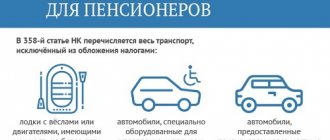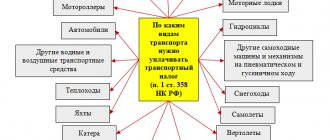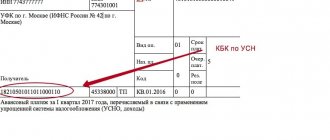The concept of transport tax and its purpose
Taxpayers of this tax are vehicle owners (both individuals and organizations) . And vehicles are subject to taxation.
The transport tax exists to compensate for the damage that transport causes to the environment and directly to roads. Transport that is subject to tax:
- Cars and trucks;
- motorcycles;
- scooters;
- buses;
- aircraft;
- helicopters;
- motor ships, yachts;
- sailing ships;
- boats;
- snowmobiles;
- motor boats;
- jet skis.
Transport tax is paid on the territory of the constituent entity of the Russian Federation in whose territory it is established (that is, registered and put into effect).
Calculation of transport tax
The amount of transport tax depends directly on the characteristics of the vehicle (object of taxation), in particular on the power of its engine. The principle is: “The more powerful the car, the higher the tax . There are standard rates and regional rates, which are set in rubles per 1 unit of horsepower.
| Car power | Rate (rub. per 1 horsepower) |
| Up to 100 horsepower | 2,5 |
| 100 - 150 horsepower | 4 |
| 150 - 200 horsepower | 5 |
| 200 - 250 horsepower | 6,5 |
| More than 250 horsepower | 8,5 |
The formula itself by which transport tax is calculated did not change in 2018 and is still calculated as follows:
tax rate * tax base * increasing coefficient.
What is the tax base? This is the base, which is determined by the engine power in horsepower. It is indicated on the vehicle registration document.
There are situations when the owner sells his car without waiting for the end of the tax period (that is, the vehicle was in his ownership for less than 1 year). In this case, the former owner will have to pay the transport tax in full, taking into account the increasing coefficient (number of months of ownership / number of months in a year).
Increasing factor. Applies not only to new vehicles, but also to used ones. Let's look at the variation of the increasing coefficient in the table:
| Cost of the car (million rubles) | “Age” of the vehicle (number of years since the year of manufacture) | Increasing factor |
| 3-5 | Less than 3 years (inclusive) | 1.1 |
| 5-10 | Less than 5 years (inclusive) | 2 |
| 10-15 | Less than 10 years (inclusive) | 3 |
| More than 15 | Less than 20 years (inclusive) |
Every year, no later than March 1 of the current tax period, the Ministry of Industry and Trade of the Russian Federation publishes a list of cars that fall under the definition of “expensive” vehicles. This list can be seen by going to the official website of the Ministry of Industry, in the “Lists and Registers” section. An increasing factor is applied to the entire list of luxury cars.
If the owner of the vehicle does not have a multiplying factor for calculation, and he has been the owner of movable property for more than a year, then the tax payment formula is reduced to the calculation:
tax base * tax rate.
Subject to transport tax
What property is transport tax levied on? This issue is regulated by the provisions of Art. 358 Tax Code of the Russian Federation. These are cars, motorcycles, buses, airplanes, helicopters, yachts and other self-propelled watercraft, jet skis, motor sleds and motor boats, as well as a number of other vehicles.
Find out how the tax base for transport tax is determined here.
Not all property that moves is taxed, but only vehicles of a certain capacity. So, they don’t pay tax:
- owners of low-power vehicles, for example, rowing and motor boats, if the power of the motor boat is no more than 5 horsepower;
- disabled people in special cars, if their engine power does not exceed 100 horsepower and they are received through social security authorities.
You need to pay tax on those types of vehicles that are subject to state registration. Some sectors of social importance (for example, agriculture, medicine, border protection and law enforcement) are exempt from paying transport tax on the transport they use. So:
- For organizations and entrepreneurs who carry out river, sea and air transportation, the following relaxation of the tax regime is provided: self-propelled vessels and aircraft belonging to them are not subject to transport tax.
- A similar benefit applies to agricultural producers. Tractors, combines and some other agricultural equipment (for example, milk tankers, livestock trucks, veterinary care vehicles) are not subject to transport tax, provided that they are used specifically for agricultural work.
- Government bodies engaged in law enforcement or military service do not pay this tax either.
- Airplanes and helicopters used in medicine are also exempt from transport tax, as are platforms (mobile and stationary) for oil drilling in the seas.
- Ships listed in the Russian International Register of Ships are also not subject to transport tax.
The tax is not paid if a car or other vehicle from an individual or organization is stolen by criminals (if the victim has documents issued by the internal affairs bodies).
IMPORTANT! The tax rate and the amount of payment depend on the power of the vehicle. Power is usually indicated in horsepower. If the data is indicated in kilowatts, then they are converted to horsepower on the basis that 1 kilowatt is equal to 1.3592 horsepower. For some property, such as aircraft, the tax is calculated on each kilogram of thrust. For specific types of transport (water or air vehicles without an engine), the tax base is determined per unit of transport.
Features and differences of payment of transport tax for organizations and individuals
Transport tax rates are the same for both individuals and organizations. However, the main difference between the system is that tax is assessed to individuals by a specialized body, while organizations are required to calculate the amount of transport tax and advance payment themselves.
Typically, notifications to taxpayers begin to arrive in mid-summer. If tax authority specialists send a notification by mail to an individual by registered mail, then it is considered received after 6 days (clause 4 of Article 52 of the Tax Code of the Russian Federation). If the letter has not arrived and the recipient is not aware of the amount of his payment, then he can find out its approximate amount on the official website of the Federal Tax Service of the Russian Federation. The service is called “Tax calculator – Transport tax calculation”. The user's region is automatically determined on the electronic page. However, if necessary, it can be changed. To calculate the tax payment, you must enter the required data indicating the benefits that the citizen has.
Note! Calculating transport tax using this service is for informational purposes only!
The tax period for both individuals and legal entities is 1 year. Individuals and Individual Entrepreneurs must pay transport tax no later than December 1 of the year following the reporting year. In simple words, the payer must pay the tax for 2017 by December 1, 2021. The deadline for payment of transport tax for legal entities is set at the regional level, but not earlier than February 1 of the year following the reporting year. Unlike individuals, organizations must also make advance payments (no later than the 10th day of the second month following the reporting period).
We remind you! Ignorance of the amount of the tax payment or simple forgetfulness of the taxpayer does not relieve him from responsibility and consequences (the accrual of fines and penalties)!
An individual becomes a transport tax payer from the day the vehicle is registered in his name. A citizen must pay tax at the place of his registration (clause 5 of Article 83 of the Tax Code of the Russian Federation).
If the owner of the vehicle changes his place of residence, and, accordingly, his registration, he is obliged to report these changes to the department of the tax authority according to his previous registration. The same rule applies to organizations (for their legal addresses). Article 85 of the Tax Code of the Russian Federation states that an organization is obliged to re-register all its vehicles at a new legal address within 10 days. And after that, you will have to pay transport tax at the new place of registration (letter No. BS-4-21/18669 dated September 19, 2017).
How to find out about debt
The date for paying the vehicle tax is approaching, but for some reason the notification has not yet arrived. As mentioned above, this must be reported to the Federal Tax Service. It is also worth checking before December 1 whether you have tax debts. This is not difficult to do, and if in the end it turns out that the tax has already been assessed, you can avoid late payment and the accrual of penalties.
You can check whether you have any transport tax debt:
- on the Federal Tax Service website in the taxpayer’s personal account (for authorization, a registration card is required, which can be obtained from any department of the Federal Tax Service);
- on the Gosuslugi portal (registration on the site is required);
- on the website of the Federal Bailiff Service (an extreme case when there is already a court ruling in a debt case).
According to the experience of friends, the first method, although it requires an effort of will to go to the Federal Tax Service and get a registration card, is worth it. Access to your personal account allows you to track and pay any taxes on time. Regarding transport tax, another convenience is that tax notifications begin to arrive in your personal account. And therefore there is no risk that they will get lost somewhere, as sometimes happens with documents sent by mail.
The sooner you pay off your debt, the better. This is due to a “tricky” feature of tax law regarding the statute of limitations. As such, there is no statute of limitations for claiming a debt. In fact, a taxpayer who has unpaid tax always remains in debt, and the tax authority always has the right to demand this debt. The only way to get rid of old debt is to recognize it as uncollectible and write it off. This can be done in court, and both the tax authority and the taxpayer can go to court.
Video: how to write off transport tax debt
Transport tax in the regions
Chapter 28 of the Tax Code of the Russian Federation reflects the main provisions that relate to transport tax. However, this is not the only regulatory act regulating this tax.
All nuances, rules and exceptions of transport tax are reflected in regional legislative acts.
Each subject of the Russian Federation has the right to independently draw up regulations governing transport tax. They reflect transport tax calculation rates, benefits, terms and payment procedures. Local authorities have the right to change the tax rate, but not more than 10 times the basic values. If the region has not established other rates, then the basic tax rates established by the Tax Code of the Russian Federation (Article 361 of the Tax Code of the Russian Federation) will be applied in this region.
It turns out that for the same car its owner will pay different amounts of transport tax, depending on the place of its registration.
It is local authorities who determine which categories of citizens will benefit from benefits. As a rule, the preferential category always includes enterprises belonging to the municipality. As for individuals, these are citizens - disabled people, pensioners and large families.
The collected fees are sent to regional budgets. The amounts received constitute a decent percentage of all budget revenue items.
To obtain reliable information about what rates apply in a particular subject of the Russian Federation, you can use the electronic service on the official website of the Federal Tax Service. Thanks to this service, any user can study the regulations governing the regional transport tax, as well as familiarize themselves with the list of benefits provided. Algorithm for familiarizing yourself with basic data on transport tax in the regions:
- Go to the official website of the Federal Tax Service of the Russian Federation;
- At the bottom of the page, click on the “Electronic Services” link.
- Among the many items, find “Reference information on rates and benefits for property taxes”;
- Select the type of tax you are interested in;
- Select a tax period;
- Select the subject of the Russian Federation of interest from the list provided;
- Confirm your selection by clicking the “Find” button.
The resulting form will reflect the legal act regulating transport tax in a particular region. You can get acquainted with it in more detail by clicking the button of the same name. Next, the user will receive the most detailed information about rates, deadlines for paying taxes and advance payments (for both individuals and organizations), as well as about tax deductions, federal and regional benefits.
Let's consider the maximum and minimum values of tax rates for transport tax by region of the Russian Federation in 2018. As comparable indicators, let’s take passenger cars with an engine power of 100 horsepower and 150-200 horsepower.
Transport tax benefits
Who can avoid paying transport tax? The list of persons entitled to benefits under this payment is established in each region separately. However, the following can count on easing the tax burden:
- disabled people of groups I and II;
- WWII veterans;
- heroes of the USSR, holders of the Order of Glory;
- public organizations of disabled people and companies organized by disabled people;
- pensioners and large families (in some regions).
Find out who has transport tax benefits in 2021 here.
Benefits come in different forms. For example, the payer is exempt from paying tax for only one car or pays half of the tax payment amount calculated on a general basis.
Companies organizing the 2021 FIFA World Cup also do not pay the tax. Transport tax holidays may be established in free economic zones. For example, residents of the Zelenograd special economic zone are provided with a 5-year benefit on this payment.
See also “Officials told when you do not need to pay transport tax.”
Information on the amount of tax payable to individuals is provided by tax authorities based on the information they have.
IMPORTANT! Until May 2014, the owner of a vehicle could not pay tax if he did not receive an INFS notification by mail in Russia. Since May 2014, citizens have been obliged, if they do not receive a notification from the Federal Tax Service, to independently transfer to the tax authority information about the property they have acquired, including vehicles (Law No. 52-FZ dated 02.02.2014). Read more about this here.
Legal entities calculate the amount of transport tax themselves based on data on movable property registered on the company’s balance sheet. The transport tax rate for 2017-2018 for organizations is determined by the regulations of the constituent entities of the Russian Federation.
How to calculate transport tax?
Go to the “Transport tax calculation” page.
Before you begin, be sure to indicate the region where your car is registered. Otherwise the calculation will be incorrect:
Next, fill in the appropriate fields. Data for the fields can be found from the PTS (vehicle passport). Click "Next":
You can skip the next step if your car is cheaper than 3 million rubles. Otherwise, select your car make and model:
After clicking the "Calculate" button, you will see the amount to be paid.
Minimum rates by region
| Region | Passenger car with 100 horsepower | Passenger car with a power of 150-200 horsepower |
| Sverdlovsk region | 0 | 32,7 |
| Kabardino-Balkarian Republic | 0-7 | 35 |
| Kaliningrad region | 2,5 | 35 |
| The Republic of Ingushetia | 5 | 10 |
| Krasnoyarsk region | 5 | 29 |
| Republic of North Ossetia-Alania | 7 | 20 |
| Transbaikal region | 7 | 20 |
Maximum rates by region
| Region | Passenger car with 100 horsepower | Passenger car with a power of 150-200 horsepower |
| Republic of Bashkortostan | 25 | 50 |
| Mari El Republic | 25 | 50 |
| Vologda Region | 25 | 50 |
| Kursk region | 25 | 50 |
| Saint Petersburg | 24 | 50 |
| Republic of Tatarstan | 10-25 | 50 |
Main changes in transport tax since 2018
One of the most popular and discussed news in the coming year was the news about the “2021 tax amnesty.” Amnesty Law No. 436-FZ came into force on December 28, 2021. At the initiative of the President of the Russian Federation, citizens were forgiven tax debt accrued before January 1, 2015. An interesting fact is that all debts and penalties were written off automatically (the law did not require an application or personal presence of debtors at the tax authorities).
Another, no less discussed piece of news were changes to the transport tax, approved by Law No. 335-FZ of November 27, 2017 “On Amendments to Parts One and Two of the Tax Code of the Russian Federation and Certain Legislative Acts of the Russian Federation.” Clause No. 68 of Article 2 of this Law states that the increasing coefficients for vehicles costing 3-5 million rubles (no more than 3 years have passed since the year of production) have been reduced.
From January 1, 2021, the coefficient for these categories of cars became 1.1. By the way, before the changes were adopted, the transport tax for the above categories of cars was applied depending on the age of the car. From 2021, for cars worth 3-5 million rubles, the increasing coefficient has been combined.
The standard transport tax rates across the country have not changed this year. There were only a few exceptions. For example, the local Duma of the Astrakhan region decided to increase rates for the following categories of vehicles ( Law of the Astrakhan region dated July 13, 2017 No. 38/2017-OZ ):
- buses and trucks with engine power exceeding 200 horsepower;
- motorcycles and scooters with an engine power of more than 35 horsepower.
And also in accordance with the Laws of the constituent entities of the Russian Federation, rates in the Republic of Mari El and the Pskov region have not changed significantly.
In 2021, changes also affected the tax return. Namely, its electronic form. The updated form of the transport tax declaration was approved by Order of the Federal Tax Service No. ММВ-7-21/668 dated December 5, 2021 . Now it does not require a taxpayer stamp.
On March 1, 2021, the list of “luxury” cars (worth more than 3 million rubles) was updated annually. As of April 26, 2021, the official website minpromtorg.gov.ru presents a list of 909 car brands that fall under the increasing coefficient.
A convenient innovation in 2021 is that now the taxpayer will be able to immediately indicate a tax benefit or deduction for a vehicle registered in the Platon .
What is the Plato system?
In 2015, a system was developed and put into operation that should cover budget losses for road repairs. But there is already a transport tax for these purposes; why and for whom was the Platon system created then?
This system is specialized for trucks. Namely, on heavy trucks weighing 12 tons or more. That is, trucks damage the road surface of federal highways and must compensate for this. The contribution to the system depends on the tariff rate and the kilometers traveled.
Interesting fact! The name of the system reflects its semantic purpose: Payment per ton - “Plato”.
Initially, truck owners paid both transport tax (in full) and transferred contributions to the system. That is, they bore a double financial burden. Don't forget about excise taxes on gasoline. Currently, the transport tax payment system for such cars has been improved.
From 2021, the amount of transport tax was allowed to be adjusted by the amount of contributions to the Platon system. If contributions to the system are equal to or greater than the amount for transport tax, then the taxpayer is generally exempt from the fiscal fee.
An exception is the situation when the taxpayer is the lessor, and the fee under the Platon system is paid by the lessee. Then the tax deduction is not provided to the taxpayer (letter of the Federal Tax Service of the Russian Federation dated February 17, 2017 No. BS-4-21/3029).
Currently, work is actively underway towards creating a unified control system for heavy trucks:
- Mass installation of special magnetic frames continues. These devices allow you to read truck license plates. And with the help of side cameras you can determine the exact dimensions;
- Heavy trucks are equipped with special equipment.
Sample of filling out a transport tax return for 2018
The organization owns a Hyundai Solaris car with an engine power of 123 hp, which was sold and deregistered on December 12, 2018. The car was produced in 2012 and registered on November 3, 2012. In the region (Moscow) there are no advance payments, the tax rate is 25 rubles/hp.
During the year, the organization owned the car for 11 months – from January to November.
The coefficient Kv for calculating tax for the year is 0.9167 (11 months / 12 months).
The calculated tax amount for 2021 is RUB 2,819. (123 hp x 25 rub/hp x 0.9167).
The amount of tax payable for the year is 2,819 rubles.









